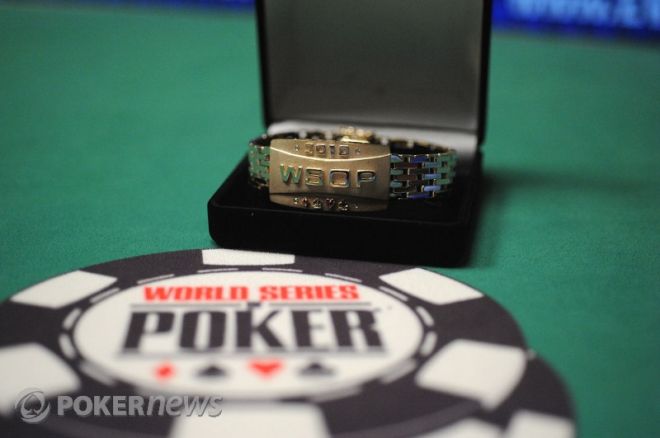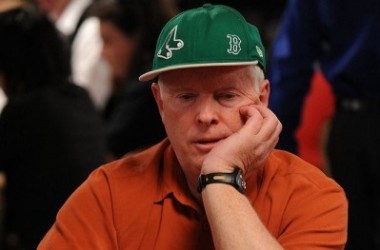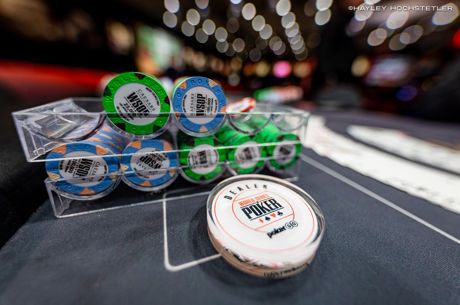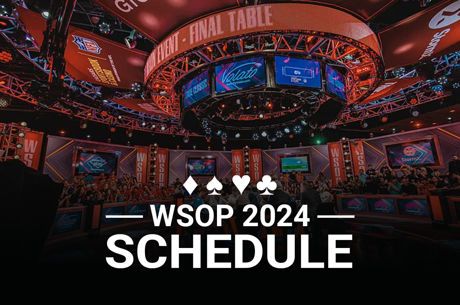History in Spades: Defunct Bracelet Events from the WSOP


The 2010 World Series of Poker featured 56 bracelets events in the different variations of hold’em, Omaha, and 7-card stud, nothing too out of the ordinary. Each year, it seems that tournament officials revise the schedule and add events they anticipate the players will appreciate. This year, that meant the change from H.O.R.S.E. to an 8-game mix for the Poker Players Championship while lowering the buy-ins to some hold'em events.
The WSOP has not always been like it is today, however. Historically, the WSOP has not featured nearly as many events as it has in recent years; for example, there were only 12 events in 1986 and 17 in 1999. This is not a surprise considering that the number of participants in years past was just a fraction of what it is today. What might surprise you are some of the events that the WSOP has hosted in the past, most of which you will not find on today's WSOP schedule.
Ace to Five Draw
One game that was a staple in the WSOP was limit ace-to-five draw. For those who might not know, this game is played much like 2-7 triple draw. Like 2-7, ace-to-five is a lowball game; however, the biggest difference lies in the strength of various hands. In ace-to-five, straights and flushes count and the ace is the lowest card; therefore, the best ace-to-five draw card combination is ace-two-three-four-five followed by ace-two-three-four-six, ace-two-three-five-six, etc.
Limit ace-to-five draw was first played at the WSOP in 1971 when Johnny Moss took down the tournament for $10,000. The event continued to appear at almost every WSOP all the way up to 2005. In fact, the last person to win an ace-to-five bracelet was Norm Ketchum , who took home $84,500 for emerging victorious in a 184-player field in the 2004 $1,500 Limit Ace-to-Five Draw event. In between, a number of notable players captured ace-to-five bracelets including Perry Green, Billy Baxter, Chau Giang, Hans “Tuna” Lund, John Juanda and Men “The Master” Nguyen. The list below shows just a sample of some notorious ace-to-five tournaments in WSOP history. Notice the slight twists on some events such as the switch from limit to no-limit and the addition of a wild card, called the joker.
| Game | Entrants | Winner (prize) |
|---|---|---|
| 1971- $1,000 Limit Ace to Five Draw | unknown | Johnny Moss ($10,000) |
| 1973- $3,000 Limit Ace to Five Draw | 7 | Joe Bernstein ($21,000) |
| 1976- $1,000 Limit Ace to Five Draw | unknown | Perry Green ($68,300) |
| 1977- $500 Limit Ace to Five Draw | unknown | Perry Green ($10,000) |
| 1982- $2,500 No Limit Ace to Five Draw | 39 | Billy Baxter ($48,750) |
| 1983- $2,500 No Limit Ace to Five Draw w/ joker | 37 | David Angel ($46,250) |
| 1986- $5,000 No Limit Ace to Five Draw w/ joker & rebuys | 32 | Mike Cox ($118,000) |
| 1987- $1,000 Limit Ace to Five Draw | 216 | Bob Addison ($86,400) |
| 1988-$1,500 Limit Ace to Five Draw | 194 | Johnny Moss ($116,400) |
| 1993-$1,500 Limit Ace to Five Draw | 138 | Chau Giang ($82,800) |
| 1996- $1,500 Limit Ace to Five Draw | 119 | Hans “Tuna” Lund ($71,400) |
| 2002- $1,500 Limit Triple Draw | 88 | John Juanda ($49,620) |
| 2003- $1,500 Limit Triple Draw | 78 | Men “the Master” Nguyen ($43,520) |
| 2004- $1,500 Limit Ace to Five Draw | 184 | Norm Ketchum ($84,500) |
Limit Omaha
Another event that became a constant at the WSOP was limit Omaha. Back in the 1980s, limit Omaha took the poker world by storm. As such, the WSOP catered to the players by establishing a limit Omaha tournament beginning in 1983. Limit Omaha’s popularity lasted for nearly two decades before it finally fizzled in the face of the now popular pot-limit Omaha. Unfortunately, limit Omaha has been on hiatus from the WSOP schedule since 2003. Shown below are just a few of the dozens of limit Omaha bracelet winners.
| Game | Entrants | Winner (prize) |
|---|---|---|
| 1983- $1,000 Limit Omaha | 51 | David Sklansky ($25,500) |
| 1993- $1,500 Limit Omaha | 103 | “Gentleman” Jack Keller ($61,800) |
| 1995- $1,500 Limit Omaha | 152 | Berry Johnston ($91,200) |
| 1999- $2,500 Limit Omaha | 104 | Tom Franklin ($104,000) |
| 2001- $1,500 Limit Omaha | 144 | Eduard Scharf ($83,810) |
| 2002- $1,500 Limit Omaha | 130 | John Cernuto ($73,320) |
| 2003- $1,500 Limit Omaha | 120 | Eduard Scharf ($63,600) |
Five-Card Stud
When the WSOP first began in 1970, the most popular game in the poker world was, arguably, five-card stud. Made famous in the Steve McQueen film Cincinnati Kid, five-card stud is played with each player receiving a single card in the hole followed by an up card. A round of betting occurs before the next card is put face up, followed by another round of betting. This is repeated four times with the hand ending after the betting on the fourth and final up card.
The popular variation had a short-lived stint at the WSOP, occurring only three times. Bill Boyd, who is generally considered the best five-card stud player of all time and enshrined in the Poker Hall of Fame in 1981, amazingly took down all three events. Interestingly, the WSOP website lists Boyd as winning the $10,000 Limit 5-Card Stud event in 1973. According to their site, Boyd won $10,000, which was the amount of the buy-in, and lists the event as having one entry, suggesting Boyd was awarded a bracelet just for entering, although this could not be confirmed. For more on Bill Boyd, check out Storms Reback’s PokerNews article on the man by clicking here.
| Game | Entrants | Winner (prize) |
|---|---|---|
| 1971 $1,000 Limit 5-Card Stud | unknown | Bill Boyd ($10,000) |
| 1973- $10,000 Limit 5-Card Stud | 1 | Bill Boyd ($10,000) |
| 1974- $5,000 Limit 5-Card Stud | 8 | Bill Boyd ($40,000) |
Five-Card Draw
In addition to five-card stud, the WSOP also hosted five-card draw events. The game is played with each player receiving five cards face-down. A round of betting occurs, players discard and draw, and a final round of betting occurs. The game is the same featured in the Mel Gibson poker flick, Maverick. Between 1978-1982, four bracelets were awarded to three players in five-card draw tournaments. Lakewood Louie was skilled enough to take down back-to-back titles in 1978 and 1979, although he only needed to defeat three opponents in '79.
| Game | Entrants | Winner (prize) |
|---|---|---|
| 1978- $5,000 Limit Draw High | 4 | Lakewood Louie ($20,000) |
| 1979- $2,000 Limit Draw High | unknown | Lakewood Louie ($24,000) |
| 1980- $2,000 Limit Draw High | 13 | Pat Callihan ($15,600) |
| 1982- $1,000 Limit Draw High | 31 | David Sklansky ($15,500) |
Mixed Doubles
While recent doubles events such as the Caesars Cup at the 2009 WSOP-Europe and the Full Tilt Poker Doubles Championship on GSN may seem like a new spin on the game, they have actually been around for a long time. Between 1979–1983, the WSOP featured mixed doubles (one man and one woman) events on the schedule. The event was played in the no-limit hold’em format for the first two years before switching to seven-card stud. The event was no joke either; in fact, one of Doyle Brunson’s ten bracelets came for his victory alongside Starla Brodie in 1979.
| Game | Entrants | Winner (prize) |
|---|---|---|
| 1979- $600 Mixed Doubles NLH | 15 | Doyle Brunson/Starla Brodie ($4,500 each) |
| 1980- $600 Mixed Doubles NLH | 41 | A.J. Myers/Lynn Harvey ($7,380 each) |
| 1981- $600 Mixed Doubles 7-Card Stud | 52 | Frank Cardone/Juanda Matthews ($7,800 each) |
| 1982- $800 Mixed Doubles 7-Card Stud | 44 | David Sklnasky/Dani Kelly ($8,800 each) |
| 1983- $800 Mixed Doubles 7-Card Stud | 50 | Jimmy Doman/Donna Doman ($10,000 each) |
Heads-Up
Although heads-up play has become quite popular and can be found at the WSOP today, this was not always the case. As a matter of fact, before 2008, only two heads-up events had taken place. The first, in 1983, was won by Berry Johnston, who went on to win the Main Event in 1986. The second, which occurred nearly 20 years later, was won by Johnny Chan, who defeated Phil Hellmuth for the title.
| Game | Entrants | Winner (prize) |
|---|---|---|
| 1983- $2,500 Heads-Up NLH | 32 | Berry Johnston ($40,000) |
| 2002- $2,500 Heads-Up NLH | 28 | Johnny Chan ($34,000) |
Chinese Poker
For two years in the mid-nineties, the WSOP hosted four Chinese poker events, also known as “13 Card Poker.” If you don’t know the rules of Chinese poker, check out Nicole Gordon’s Chinese poker article , which explains the rules nicely. The first two events were held in 1995 and saw respectable numbers; however, in the following year, the number of entrants declined in both Chinese poker events. Combined with the fact that the mechanics of the game, both in the deal and in play, are time-consuming, it is no surprise the WSOP did away with this event.
| Game | Entrants | Winner (prize) |
|---|---|---|
| 1995- $1,500 Chinese Poker | 89 | John Tsagaris ($41,400) |
| 1995- $5,000 Chinese Poker w/rebuys | 24 | Steve Zolotow ($112,500) |
| 1996- $1,500 Chinese Poker | 62 | Gregory Grivas ($37,200) |
| 1996- $5,000 Chinese Poker | 10 | Jim Feldhouse ($50,000) |
Follow us on Twitter and "like us" on Facebook.

PR & Media Manager for PokerNews, Podcast host & 2013 WSOP Bracelet Winner.







